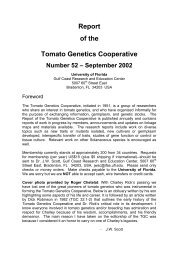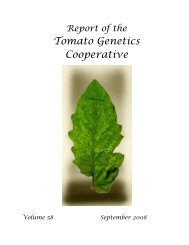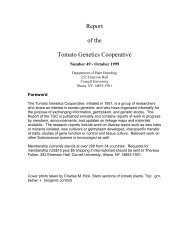tomatoes and peppers grown in the field or greenhouse (Brown et al., 2010) in Central America. No universally accepted name exists for this disease on tomatoes, as illustrated by the use <strong>of</strong> different names: tomato vein-greening in Arizona (Brown et al., 2010), permanent yellowing in Mexico (Munyaneza et al., 2009b) and Paratrioza disease in Guatemala. At least from our observations in Guatemala several symptoms are notable: flower abortion, purpling <strong>of</strong> the leaf margins, stem thickening, yellowing <strong>of</strong> younger leaves, and stunting. An internet search reveals that there is a substantial number <strong>of</strong> sources using „permanente del tomate‟ or permanent yellowing disease <strong>of</strong> tomato. Thus, it is proposed that this diseased be named Liberibacter permanente del tomate or Liberibacter yellowing disease <strong>of</strong> tomato. This would distinguish this disease from psyllid yellows (Brown et al., 2010). 56
Literature Cited: Brown, J.K., Rehman, M., Rogan, D., Martin, R.R., and Idris, A.M. 2010. First report <strong>of</strong> „Candidatus Liberibacter psyllaurous‟ (synonym „Ca. L. solanacearum‟ associated with „tomato vein-greening‟ and „tomato psyllid yellows‟ dieseses in commercial greenhouses in Arizona. Plant Dis. 94:376. Crosslin, J.M., and Bester, G. 2009. First report <strong>of</strong> „Candidatus Liberibacter psyllasurous‟ in Zebra chip symptomatic potatoes from California. Plant Dis. 93:551. Garcia, B.E., Graham, E., Jensen, K.S., Hanson, P., Mejía, L., and Maxwell, D.P. 2007. Co-dominant SCAR for detection <strong>of</strong> the begomovirus-resistance Ty2 locus derived from Solanum habrochaites in tomato germplasm. Tom. Gen. Coop. Rept. 57:21-24. Liefting, L.W., Weir, B.S., Pennycook, S.R., and Clover, G.R.G. 2009a. „Candidatus Liberibacter solanacearum‟ associated with plants in the family Solanaceae. Internat. J. System. and Evolut. Microbiol. 59:2274-2276. Liefting, L.W., Sutherland, P.W., Ward, L.I., Paice, K.L., Weir, B.S., and Clover, G.R.G. 2009b. A new „Candidatus Liberibacter‟ species associated with diseases <strong>of</strong> Solanaceous crops. Plant Dis. 93:208-214. Munyaneza, J.E., Sengoda, V.G., Crosslin, J.M., Garzón-Tiznado, J.A., and Cardenas- Valenzuela, O.G. 2009a. First report <strong>of</strong> „Candidatus Liberibacter solanacearum‟ in pepper plants in México. Plant Dis. 93:1079. Munyaneza, J.E., Sengoda, V.G., Crosslin, J.M., Garzón-Tiznado, J.A., and Cardenas- Valenzuela, O.G. 2009b. First report <strong>of</strong> „Candidatus Liberibacter solanacearum‟ in tomato plants in México. Plant Dis. 93:1079. Páramo Menchaca, V. Estrategia integrada: control de Paratrioza, pulgón saltador o psílido de la papa y el tomate. Productores de Hortalizas. April, 2007. Rehman, M., Melgar, J.C., Rivera, J.M., Idris, A.M., and Brown, J.K. 2010. First report <strong>of</strong> „Candidatus Liberibacter psyllaurous‟ or „Ca. Liberibacter solanacearum‟ associated with severe foliar chlorosis, curling, and necrosis and tuber discoloration <strong>of</strong> potato plants in Honduras. Plant Dis. 94:376. Secor, G.A., Rivera, V.V., Abad, J.A., Clover, G.R.G, Liefting, L.W., Li. X., and De Boer, S.H. 2009. Association <strong>of</strong> „Candidatus Liberibacter solanacearum‟ with Zebra Chip disease <strong>of</strong> potato established by graft and psyllid transmission, electron microscopy, and PCR. Plant Dis. 93:574-583. Smart, C.D., Schneider, B., Blomquist, C.L., Guerra, L.J., Harrison, N.A., Ahrens, U., Lorenz, K.-H., Seemuller, E., and Kirkpatrick, B.C. 1996. Phytoplasm-specific PCR primers based on sequences <strong>of</strong> the 16s-23s rRNA spacer region. Applied and Environ. Microbiol. 62:2988-2993. 57
- Page 1 and 2:
Report of the Tomato Genetics Coope
- Page 3 and 4:
Table of Contents Foreword 2 Announ
- Page 5 and 6: Upcoming meetings: February 17-19,
- Page 7 and 8: Opena et al., 1989; Celine et al.,
- Page 9 and 10: esistant lines, a specific bitter t
- Page 11 and 12: esistance and very large fruit (Sco
- Page 13 and 14: esistance and agro-climatic adaptat
- Page 15 and 16: esistance, and breeding in geograph
- Page 17 and 18: acteria (vascular or not) and even
- Page 19 and 20: Abinne (librarian at INRA-CRAAG, Gu
- Page 21 and 22: origin Table 1. Summing up of the p
- Page 23 and 24: Literature cited 1. Acosta J.C., 19
- Page 25 and 26: complex. C. Allen, P. Prior and C.
- Page 27 and 28: 63. Mew T.W., Ho W.C., 1977. Effect
- Page 29: 93. Wang, J.-F., P. Hanson, and J.A
- Page 37: Figure 9 : Pedigree of ‘CRA74’,
- Page 42 and 43: provide a rationale for pyramiding
- Page 44 and 45: was evaluated in relation to the pa
- Page 46 and 47: The parents had average DSIs of 0.6
- Page 48 and 49: The average DSI for RS families wit
- Page 50 and 51: Combinations of introgressions Ty3a
- Page 52 and 53: Literature Cited: Abinder, I., Reuv
- Page 54 and 55: Research Papers TGC REPORT VOLUME 6
- Page 58 and 59: Research Papers TGC REPORT VOLUME 6
- Page 60 and 61: flowers have smaller and lighter gr
- Page 62 and 63: Stoeva P., Dimaculangan 2 D., Radko
- Page 64 and 65: Fig. 4: CLSM photographs of epiderm
- Page 66 and 67: Revised List of Wild Species Stocks
- Page 68 and 69: S. cheesmaniae (L. cheesmanii) LA04
- Page 70 and 71: S. chilense (L. chilense) LA2767 Ch
- Page 72 and 73: S. chmielewskii (L. chmielewskii) L
- Page 74 and 75: S. galapagense (L. cheesmanii f. mi
- Page 76 and 77: S. habrochaites (L. hirsutum, L. hi
- Page 78 and 79: S. lycopersicoides LA4130 Pachica (
- Page 80 and 81: S. lycopersicum (L. esculentum var.
- Page 82 and 83: S. lycopersicum (L. esculentum var.
- Page 84 and 85: S. lycopersicum (L. esculentum var.
- Page 86 and 87: S. ochranthum LA2166 Pacopampa Caja
- Page 88 and 89: S. peruvianum (L. peruvianum) LA153
- Page 90 and 91: S. pimpinellifolium (L. pimpinellif
- Page 92 and 93: S. pimpinellifolium (L. pimpinellif
- Page 94 and 95: S. pimpinellifolium (L. pimpinellif
- Page 96 and 97: Appendix. Wild species core collect
- Page 98 and 99: 98 S. lyc. cerasiforme LA4133 LA024
- Page 100 and 101: SolCAP LA2675 LA2744 LA2779 LA2788
- Page 102 and 103: Coulibaly, Sylvaine Nunhems USA, 70
- Page 104 and 105: McCaslin, Mark FLF Tomatoes, 18591
- Page 106 and 107:
Stommel, John USDA-ARS, Genetic Imp





